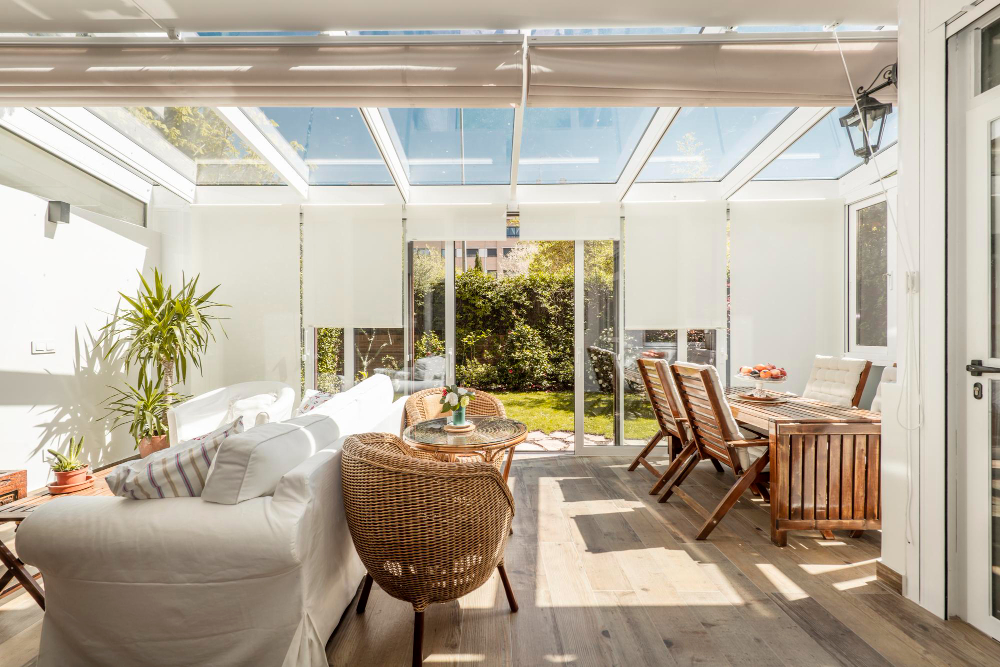Last updated on
If you’re only planning to add a small extension to your home, you may think you’re limited in terms of style. But you can still create that wow factor despite a small footprint. By making use of materials such as wood, metal and glass, you can elevate your design to another level and transform the look of your home.
What's Inside
Incorporate Wood

Wood is a great material to use in extensions. Thanks to its natural tone and graining, its capable of instantly transforming a small extension into something really beautiful.
Timber can be used in different ways, such as in the framework and cladding, to create traditional character or a high-end, modern design.
Wood cladding can create an eye-catching contrast to brick and left to weather naturally, it will blend seamlessly into the garden. Slatted cedar and larch cladding can be used horizontally or vertically to give your small extension a Scandi feel and used with black-framed windows, it will have a contemporary edge.
If it’s more of a traditional look you’re after, then a timber-framed extension in oak or a similar hardwood can achieve that. As the extension is small, you really want to maximise light, so building an orangery is a good option.
A timber roof lantern and window frames in a cottage, Edwardian or Victorian style will complete the look. Here you could choose to keep the natural wood on show or paint it in a heritage colour such as sage green.
Not all timber framed extensions need to look traditional though. For instance, a design incorporating timber fins will give your extension a striking modern, geometric look.
Go Modern
Going for a modern design is certainly going to give your small extension that wow factor. The use of unusual angles is a great design trick to use when you want to create something unique. For instance, an extension doesn’t need to be rectangular. A pointed, trapezoid or triangular footprint will not only add a bit of drama, but it can also save you some outside space.
Of course, you don’t need to draw up any special designs to create a modern-looking extension, you could simply use metallic materials in the cladding. Copper and zinc both develop a patina over time, enabling you to achieve a completely unique and characterful extension while steel and aluminium can be coated to achieve a durable finish in any colour you choose.
That’s not the only way to use metal in a modern extension design. The clever use of steel beams works too. It’s likely you will need a few of these for your supporting structure and most of the time they’re hidden away behind brick and plasterwork.
But why not make a feature of them instead? Leaving them exposed and painting them in a bright colour will create a standout feature that’s cost-effective. Steel can also be used to great effect in the framework. Steel-framed extensions are not only easy to put up but they make a great partner to glazing.
Maximise Glazing

Having a glazed extension can give you that wow factor. By using lots of glass you create a close connection to the garden and bring in lots of light. So, your interior is going to look bright and airy, even with a small box or side-return extension.
If you’re going for a glazed rear extension in a modern or minimalist style, consider corner bi-folds to really open the space out and create an unforgettable indoor-outdoor entertaining area. Also think about maximising the glazed effect with slim frames, giving you an unhindered view of the garden.
Should you decide to go with lots of glazing in your extension, you’ll need to think about heating and cooling. External architecture such as a brise-soleil can help prevent overheating as can solar control coating on the glass.
It’s also worth thinking about other glazing features you can use. Low-iron glass will give you a really clear view into the garden while self-cleaning glass can help you maintain the look of your extension. Tinted layers inside the glazing or louvre-style panels outside the extension can help to boost privacy.
Add the Unexpected
Extensions don’t actually need to be square or boxy. If you want to give your small extension a distinctive look, then why not add in some curves? You could round off one corner of a rear extension or add a port hole to a side extension. Or perhaps go with a curved roof instead of a flat one.
Alternatively, you could add a curved canopy to the outside of your extension. This would not only create a more high-end design but it could give you a more practical patio area. You might also think about mirroring the curves of your extension in your garden landscaping to give you a cohesive and stylish exterior.
There are other ways to make your extension look bespoke. Instead of using wood or metal cladding, you could use exterior wall tiles. Split-face tiles are great for adding texture and patterned designs work well with white render to create a Mediterranean-style extension.
Plain glazed tiles are an effect way to add blocks of colour without relying on paint. They can mimic the patterning of your brickwork while adding a bold splash of blue or green.




